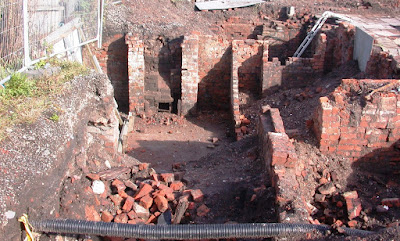Over the years, every once in a while I have experienced some degree of meagre good fortune or luck.
 |
| Easter Sunday March 27, 1910, Toronto, Ontario. Henry Bailey Pember centre |
Whether it was a rare open parking spot on a crammed street, small winnings in the hockey pool at work, or the time in grade 4 when I guessed correctly on how many candy canes were in the prize jar, I’ve had a few graces come my way.
Never did I imagine, however, a priceless treasure that would be revealed to me, a treasure hidden for years.
My interest in genealogy, something which formed as a mild but unpursued curiosity as a child, expanded rapidly two years ago as I sat with my ill father in a hospital room in Woodstock, Ontario.
Due to a weak heart and respiratory illness, he was on death’s door, and it was during the course of conversation one day in that palliative room that I simply asked him where his mother was from.
Learning of the birthplace of my grandmother, Laura Isadora Hall of Derby, kindled a renewed and much deeper interest in family origins and history. As I delved into genealogical research, I was able to make contact with cousins of whom I previously knew nothing about, cousins in both the Old and the New World.
 |
| Meeting with Ken Cox and family, Ken is second from right, January 2016 |
Through hours of research and reading over documents, I have gained knowledge of family branches, of incredible personal histories, twists, tragedies and triumphs.
Most important, however, is the establishment of contact, meeting and the bonding with members of my widespread family.
Even then, I feel that I still have just touched the tip of the iceberg.
It was through the online sharing of old photos by some of these family members, several of whom are well-accomplished genealogists who have taken much time and effort to preserve family memories, that I was able to print off pictures for my terminal father to see before he passed away. He was able to learn more of his family’s history, both sides, and before his eyes came the pictorial memories of previous links in the chain.
I still recall the childlike excitement I felt inside every time I brought a new picture to him, with the story behind it. For me, not only was it a process of discovery of identity, but also a last service to a dying father.
One picture, in particular, has touched me in a way that I can only describe as bittersweet. On Easter Sunday, March 27th, 1910, in a photographer’s studio in Toronto, Ontario, posed the first Canadian Pember family of my immediate line.
His name was Henry Bailey Pember, a 2nd-great-grandfather who with his wife Sarah Hampson Pember, had emigrated to Canada from England in the nineteenth century. Mother Sarah had passed away three years earlier, but there in the old photo, are the children with their father, they themselves the root and branches of a family which has spread too many provinces in this country.
This old, beautiful photo had thankfully been preserved in the collection of the caretaker of many similar photos and documents, my cousin Ken Cox of Orillia, Ontario. Ken’s grandmother, Alice Victoria Pember Cox, was one of the young women in the photograph, she being one of the daughters of Henry and sister to my great-grandfather, William Hampson Pember.
Through the years, Ken has compiled and safeguarded a large depository of family history.
We were able to make contact through Ancestry.com, previously knowing nothing of each other, and this last winter were able to meet for the first time.
Now, at that time I had recently seen a smaller copy of the family portrait, but meeting Ken that day at his house, I was amazed when he brought out the large original and asked me to take on the task of caretaker of the photo.
I gladly obliged and seeing this family treasure for the first time, knowing that I would act as its new custodian was a very emotional experience for me. For, I not only felt the joy of the photo’s discovery, but also the sadness knowing that my father, who had passed away only months earlier, would have very much desired to see such a great family treasure.
Several months later, this great photograph now hangs over my fireplace, beautifully framed by the expert hands of Elizabeth McKinnon of McKinnon Custom Framing.
Sitting under museum glass, with the names of each of the family members listed, so that posterity and future generations of the Pember family will know and remember the faces of the earliest links of the chain.
© Chris Pember, 2016
Location; Canada
Pictures; E
aster Sunday, March 27th, 1910, Toronto, Ontario. Henry Bailey Pember, centre, William Hampson Pember, fourth from left, Alice Victoria Pember Cox, farthest on right and meeting with Ken Cox (second from right) and family in January 2016. he Hidden Treasure
from the collection of Ken Cox and Chris Pember




.jpg)












































